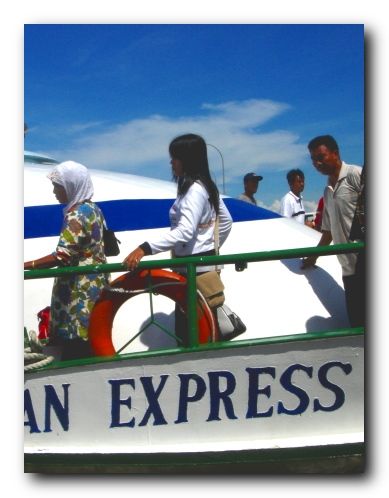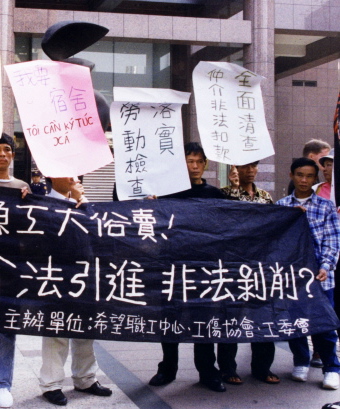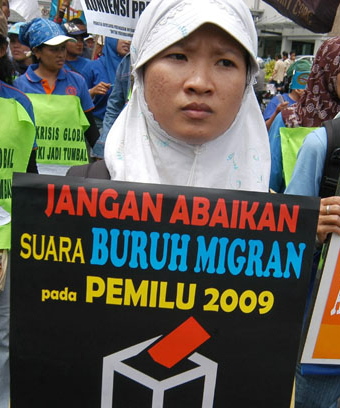Rapid construction of a COVID-19 hospital is a rare good news story for the government but the motives behind it remain unclear
Jemma Purdey and Antje Missbach
In response to the COVID-19 pandemic, in early March the Indonesian government enacted an emergency plan to build a 1000-bed specialist hospital on Galang Island in Riau Islands Province. Together with the Ministry for Public Works and Public Housing (PUPR), the Indonesian Military (TNI) led the construction of the hospital, which was completed in four weeks, officially opening as a 360-bed facility on 7 April.
Located over 1200 kilometres from Jakarta, the epicentre of Indonesia’s coronavirus outbreak so far, the decision to build the hospital on Galang Island appears to have been driven by concerns about a projected influx of returning migrant workers (TKI) and their potential to bring the virus with them. The rapid construction of the hospital, staff accommodation and other facilities on Galang Island has been a rare good news story for the government in the face of criticism of its early handling of the pandemic.
Camp Vietnam
This is not the first time that Galang Island has been the site for such a coordinated, rapid and large-scale infrastructure project under the leadership of the military. Over forty years ago, in June 1979, the Vietnamese refugee emergency was unfolding across the region after the end of the war in Vietnam. An agreement was reached between Indonesia, some other Southeast Asian states, and the United Nations High Commissioner for Refugees (UNHCR) to facilitate a program of transit and resettlement for the refugees in safe third countries.

From 1979 to 1996 the 80-hectare refugee camp processed between 122,000 and 145,000 people, most of them Vietnamese refugees who had arrived by boat directly from Vietnam or had been rejected by Malaysia prior to reaching Indonesia. Later, the Vietnamese were followed by refugees from Cambodia.
The agreement with Indonesia stipulated that the refugees would stay on Galang Island only for a ‘reasonable period’ while they were being processed for resettlement, predominantly in the USA, Canada and Australia. Important factors in the choice of Galang as the site for the processing centre were its size, its relative proximity to existing settlements of refugees in the nearby Anambas Islands and to the international port in Singapore, and its deep-water harbour. Another important reason for choosing Galang to house refugees awaiting resettlement was to separate them from and minimise interactions with the local population. Though over 8000 hectares in size, only 200 Indonesians were living on the island in 1979.
The construction of the refugee camp on Galang proceeded with great haste. Despite some early concerns about the technical and design details of the construction, the efficiency of the Indonesian operation was widely lauded at the time by its international partners including members of the United Nations, the International Red Cross and Médecins Sans Frontières.
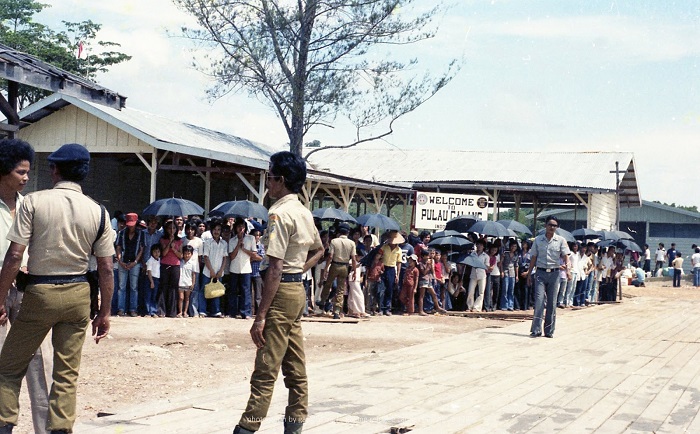
The government departments of foreign affairs and home affairs were given coordinating roles related to providing facilities in the camp and negotiating with third countries for onward resettlement, but establishment and administration of the camp was in large part a military-led operation. The construction and running of refugee camps was a new task for Indonesia, but managing island detention camps such as on the prison island of Buru, was already a preoccupation of the Indonesian military and state elsewhere in the archipelago.
In July 1979, the Ministry of Defence established the Management Committee for Vietnamese Refugees (Panitia Pengelolaan Pengungsi Vietnam, P3V). It was composed of army, navy, immigration and police personnel and tasked with coordinating the settlement, administration, processing and security of the refugees in the camp. P3V was also responsible for conducting screening interviews with the Vietnamese refugees and making decisions on whether asylum should be granted or not. Reports from former camp residents and international staff on the island tell of endemic corruption and extortion among the local P3V staff.
With the exception of 12,000 refugees who arrived on Galang after 1989 and were repatriated to Vietnam after their claims for asylum were rejected, most were resettled in Western countries, including the USA and Australia.
Initially the local population on Galang welcomed the centre’s establishment, as it offered temporary employment. Later, as the refugees kept arriving and the camp became overcrowded, friendly relations faded as resentments grew. Inside the camp, people were housed in barracks containing up to a hundred people. But it had a clean water supply, sanitation, schools, a hospital and even a port. Compared to local standards, conditions in the camp were basic but relatively good.
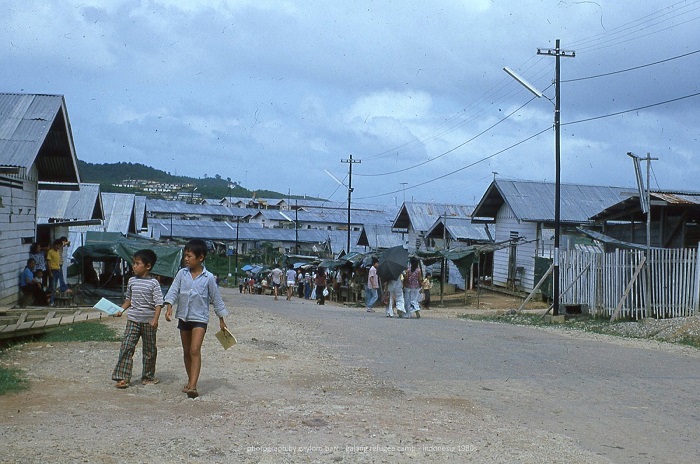
However, as the window of opportunity for resettlement began to close, the refugees became increasingly desperate leading to a rise in cases of violence, rape and suicide in the camp.
Nowadays, the refugee camp on Galang lie in ruins, apart from a relatively newly built Buddhist temple and a number of renovated gravestones placed in the cemetery by former camp residents or their relatives. Some years ago, a museum was established to document life in the camp in enthusiastic terms and, since the camp’s closure, tourism to the island has been encouraged by various governments. Without necessary investment in facilities and infrastructure, however, visits have largely been limited to locals and former camp residents.
COVID-19
On a scoping visit to Galang on 4 March 2020, TNI commander Air Chief Marshal Hadi Tjahjanto told reporters that Galang was just one of the sites being considered for the specialist hospital. With only 17,000 inhabitants, Galang has kept its rural character unlike the crowded city of Batam. He noted that one of the reasons it was favoured was because several of the site’s buildings still remained from its time as a refugee camp. It is reported that the delegation visited religious buildings, a former hospital, and logistics buildings. It can only be assumed that after his visit the commander concluded these buildings were entirely unsuitable for present day use.
On our visits to the island in the past few years, we have both observed firsthand that any remaining infrastructure is badly maintained save for the Camp Galang Museum (a former school house) and the places of worship on the island. As the journalists accompanying the scoping delegation in early March also discovered, the camp hospital itself is in extreme disrepair.
Not surprisingly, a week later when construction began plans for the hospital indicated an almost entirely new construction project covering 20 out of the 80 hectares made available on the island, with an allocated budget of Rp.400 billion (AUD$40.5 million). The infrastructure on the island was so neglected that the Ministry of Public Works and Public Housing (PUPR) needed to install a 13.8 kilometre pipeline to bring clean water to the island for the hospital project.

The project is divided into three zones with two of them now complete. Zone A is situated in the former Camp Pengungsi Vietnam (Vietnam Refugee Camp) and is said to have included the renovation of some existing buildings to turn them into a laundry, a pharmacy and other facilities for hospital staff. Zone B is an entirely new development for the hospital itself, including isolation units, ICU and laboratories. Three helipads are in the original design for the facility and a fleet of ambulances has been assembled to ferry patients from Batam’s Hang Nadim Airport 70 kilometres away.
The hospital is staffed by medical personnel from the military, the National Police and the Riau Islands provincial administration, as well as volunteers.
Why Galang?
In early March the government initially reported that the hospital would prioritise returning migrant workers. President Jokowi was particularly concerned at the growing numbers of migrant workers returning from Malaysia and feared many more would return ahead of Idul Fitri, the celebration at the end of the fasting month. The contracts of many of these workers expire ahead of Ramadan meaning that if they were to stay on in Malaysia they would be considered illegal, so would be compelled to find ways to come home.
Batam represents a potential weak point in Indonesia’s efforts to control flows of people from overseas, especially from nearby Singapore and Malaysia. It enjoys a relatively open border to support the strong economic links connecting workers and tourists travelling back and forth between these countries. In 2018 the Batam Immigration Office recorded around 3.3 million passengers entering the city through its five international ferry ports. Of these, 1 million were Singaporeans, while 1.6 million were Indonesians. In addition to the documented visits, Batam is also known to be a gateway for undocumented migrant workers travelling to and from Malaysia.

Nonetheless, it is not yet clear to what extent the Riau Islands provincial government was consulted about the decision to build the hospital on Galang, though it is involved in the development project and is providing administrative support.
The extreme time pressure to deliver the project meant that there was no consultation with the local population. As soon as the news broke of the decision to build the hospital on Galang the local press was especially keen to know who the hospital would cater for, specifically if it would be reserved solely for migrants workers or Jakartans, and exclude locals. When reporters visited the island in early March locals were quoted as being strongly against the proposal to build the hospital there. They cited a range of concerns including that the island would become synonymous with COVID-19, that local authority over the island would be ceded to Jakarta and that the historic refugee camp would no longer be open to tourists, depriving locals of the albeit small income the museum generates. Moreover, they were alarmed at the prospect that a hospital would be built that would not be open to them.
Open for business
At the official opening of the hospital on 7 April, Indonesian Military Regional Defence Joint Command I (Kogabwilhan I) commander Vice Adm. Yudo Margono revised the initial statements about who could access the hospital. He told the media they would accept patients from across the archipelago, not only returning migrant workers. Special reference was made to an overflow of patients from Jakarta. However, just how many or how they would be transported to Galang, was not made clear.
Three weeks after the hospital was opened, 43 patients had been admitted to the new hospital, 39 of whom were crew from the Pelni (Indonesian National Shipping) owned ship KM Kelud, who had all tested positive for COVID-19 when they were admitted ten days earlier. On 27 April, Kompas and other news outlets reported that a coronavirus patient referred by local authorities in Batam was rejected by the RS Galang on the basis that it was not receiving ‘general’ patients, only returning migrant workers, crew (ABK) and pilgrims returning from Malaysia, with mild to moderate cases of the virus.

However, there were no returning migrant workers among the 43 patients in RS Galang at that time, although they are most certainly coming home from Malaysia and Singapore in larger numbers than officially accounted for. The reality is that many prefer to return to Indonesia clandestinely, which means hiring a boat and crew to pick them up in Malaysia and shuttle them across. This is particularly common amongst labour migrants whose passports, visa or work permits have expired. Although there are ways to get new travel documents at the Indonesian Embassy in Kuala Lumpur, for example, this is not always easy. For plantation workers in rural areas this would be more hazardous and expensive than simply going home by boat. Many migrant workers are from Eastern Indonesia, who would transit briefly in Batam.
It is hard to say how many migrant workers have been returning since the outbreak as there are literally hundreds of pelabuhan tikus (secret landing spots) in Batam and neighbouring islands. However, with as yet no returning migrant workers admitted to quarantine or as patients at the new hospital, and with local patients being turned away, some have already begun to question why such a remote location was chosen for what is so far Indonesia’s only dedicated and purpose built COVID-19 medical facility.
End game?
The speed with which the new hospital and other facilities were built on Galang, is a rare good news story for the government as it faces its critics over its handling of the pandemic. Led by the central government and military, it does, however pose questions also raised elsewhere about the degree to which provincial and local levels of government are involved in these efforts, or even consulted. The construction of the hospital began on 11 March, led by state-owned construction company PT Wijaya Karya (WIKA), which includes ex-military and current State Intelligence Agency (BIN) staff on its board. Whilst the project is a joint one involving various levels of government and its agencies, the hospital is now under the supervision of Maj. Gen MS Fadhilah, the commander of the Bukit Barisan I Military Command that oversees the provinces of North Sumatra, West Sumatra, Riau and Riau Islands. In what could potentially become a point of tension, the operational costs and salaries of medical staff will be administered and paid for by the Riau Islands provincial government from funds allocated through the Special Allocation Fund (DAK). Just how well this arrangement of managerial and administrative responsibilities is shared between the military command and the provincial government remains to be seen.
Whilst the coronavirus is being approached in many countries around the world as a national security issue, an increase in the prominence of the military, police and intelligence agencies in Indonesia comes at a time when its democracy is widely considered to be weakening. In light of the military’s past role in politics and its more recent attempts to make a comeback, its leading position on projects such as the COVID-19 hospital on Galang Island should be watched with a critical eye.
Antje Missbach is author of Troubled Transit: Asylum Seekers stuck in Indonesia, ISEAS: Singapore, 2015. Jemma Purdey is a member of the board of Inside Indonesia. Both are co-authors, with Dave McRae of Indonesia: State and Society in Transition, Lynne Reinner, Boulder Co., 2020.


